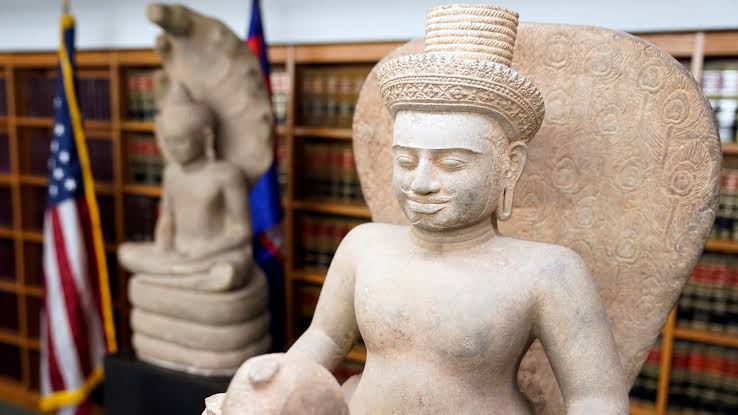US returns 30 stolen antique artworks to Cambodia, Britain should do the same

The US on Monday returned 30 stolen works of art and antiquities to Cambodia that had been looted from the Southeast Asian nation, including from an ancient Khmer city, and illegally trafficked around the world for decades.
Manhattan federal prosecutor Damian Williams officially handed over the looted antiquities to Cambodia’s Ambassador to the US, Keo Chhea, in front of press.
Among the 30 works was a 10th-century sculpture of the Hindu deity Skanda, seated on a peacock, as well as a 10th-century sculpture of the Hindu god Ganesha. Both were stolen from Koh Ker, the ancient Khmer capital located 80 kilometers from the renowned temples of Angkor, Williams’ office said in a statement.
The antiquities, which range from the Bronze Age to the 12th century, had been stolen along with thousands of others during the wars in Cambodia in the 1970s and when the country reopened in the 1990s.
The federal prosecutor’s office said that thousands of Khmer statues and sculptures were trafficked out of Cambodia over the course of decades to antique dealers in Bangkok, Thailand, before being illegally exported to collectors, businessmen and even museums in Asia, Europe and the US.
The New York prosecutor’s office is involved in the restitution of a vast array of works. From the summer of 2020 to the end of 2021, at least 700 pieces have been returned to 14 different countries, including Cambodia, India, Pakistan, Egypt, Iraq, Greece and Italy.
In 2021, US collector Michael Steinhardt returned about 180 antiquities stolen from around the world in recent decades as part of a deal with the government.
The agreement between the US judicial system and Steinhardt, 80, allowed him to escape an indictment but prohibits him from acquiring works on the legal art market for the rest of his life.
Angkor, which at 400 square kilometers is the largest archaeological site in the world, was the capital of the Khmer Empire, which lasted from the 9th to 14th centuries. The site, which recently reopened to tourists after a two-year pandemic-induced closure, was designated as a UNESCO World Heritage Site in 1992.
Britain should take a note of the above and should start returning all the LOOT from India and other countries, which they display in London museum and on the British Crown itself.




